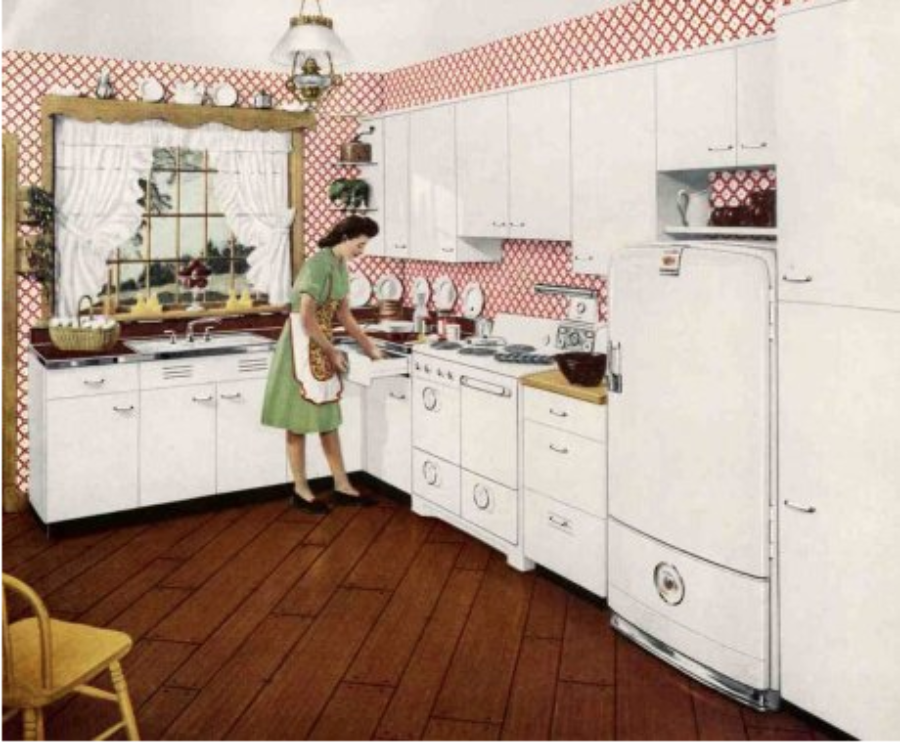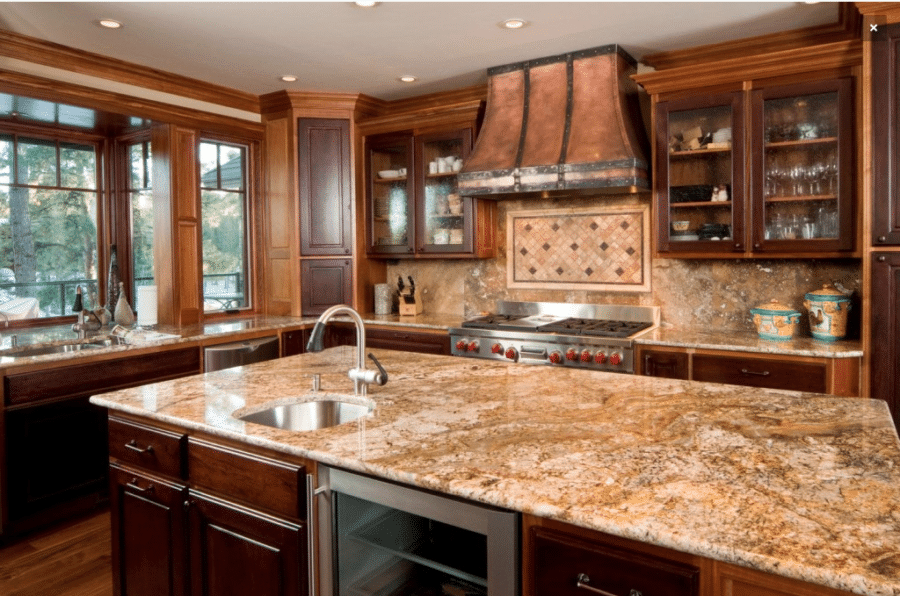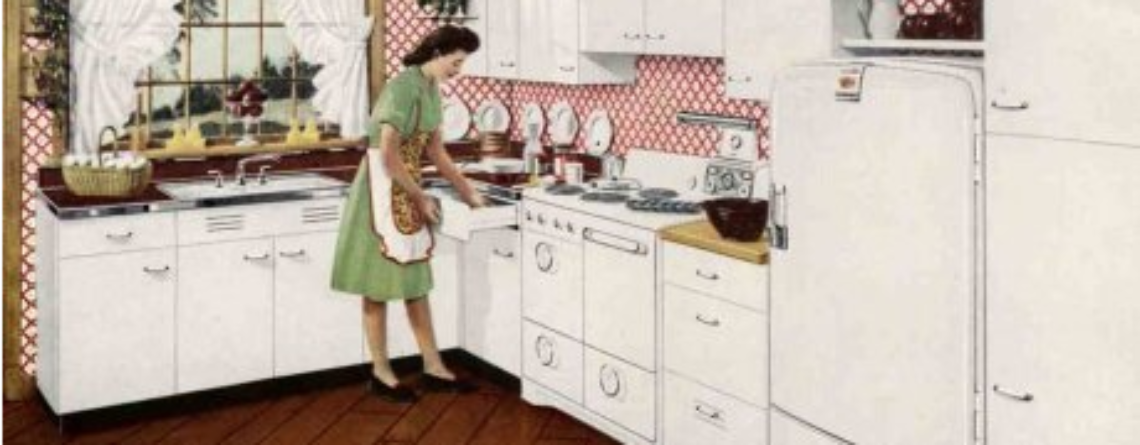One of the most common questions we get in our industry is “What are the current kitchen trends?” Often, we hesitate to fully answer that question, as a great design should be more of a reflection of the person living there than including the hottest feature from the latest design magazine. However, trends in kitchen design are often more about evolution than the latest craze. Let’s take a look at how kitchens have evolved over the last hundred years, and how trends turned into timeless features.
1920’s

At the turn of the century, electricity and indoor water systems became the norm and kitchens were an integral part of the main house, either moved in from a separate building or from the basement. By 1920, kitchen were mostly bare rooms to start, with a wall-mounted two-legged sink with drain board. Freestanding gas ranges allowed for ease of cooking without the need for open fires over wood or coal. Cabinetry was also freestanding, and kitchen tables were used for work surfaces. In-home refrigerators were popularized in the later 1920’s, but often cost more than the Model T Fords of the time, so many households still used iceboxes.
1930’s

Refrigerators became a staple of the 1930’s kitchen and food preparation became much easier with introduction of countertops and built-in cabinetry the goes to the ceiling. The free-standing range became a little smaller with the advent of the electric stove, and the sink was integrated into the countertops. Fewer homes relied on domestic help, and the average middle-class housewife began to spend more time in the kitchen.
1940’s

Style begins to emerge in the ‘40’s. Bright, primary colors, laminate countertops with metal edging and metal cabinets are all the rage. Most appliances are electric, and become more stylized with their rounded corners. The separate freezer compartment on the refrigerator makes an appearance.
1950’s

The mid-century ushers in the dawn of modern design, and post-war homes are built at record levels. Metal cabinets continue to be popular, painted in bright and pastel colors. The wall oven is introduced, and the upper cabinets are suspended under soffits. The peninsula makes an appearance, creating a space for a “breakfast room.”
1960’s

Probably the most significant invention since the electric refrigerator, the dishwasher is introduced to the American kitchen, but it was considered an expensive luxury and won’t become standard until later. Dark wood cabinetry replaces the metal of the previous decades, and colorful appliances continue to be popular. In newer built homes, kitchens begin to transition into the living spaces and the concept of the “work triangle” is developed.
1970’s

Large patterned wallpaper, avocado green and harvest gold appliances; yes, a 70’s kitchen is a thing to behold. Heavy, dark cabinetry were typical in a suburban kitchen from this time, and while colorful and patterned laminates were still popular, many opted for tile countertops. Microwaves, although often oversized, became the newest appliance sensation. And while we all remember the funkiness of the 70’s kitchen, the decade really made the kitchen part of the living space, with its spindled half-walls and use of peninsulas and islands.
1980’s

Things got lighter and brighter in the 80’s with more yellow oak and blond woods. Warm tones were also found in the brass hardware and light fixtures, and box lights over the larger islands created more functional working spaces. Square tile and wood floors were both common, and the breakfast room was often built into a bay leading to the back deck.
1990’s

We begin to see more themes in kitchen design, and Tuscan was particularly popular at this time. Painted and distressed cabinets, tumbled stone backsplash, elaborate hardware, heavy detail in the millwork, and islands made to look like large pieces of furniture were common of the time. Granite countertops become the latest luxury, and new homes are built with open floor plans, where the kitchen and breakfast area spill into the family room with little separation.
2000’s

Granite has become the standard in many kitchen, as well as under mount sinks for a clean look. Cabinetry is often painted white, although many opt richly stained cabinets as a departure from the yellow oak ‘80’s. Stainless steel appliances, brushed nickel and oil-rubbed bronze hardware are the popular finishes. The kitchen island has become truly grand, making the kitchen the hub of the activity in the home.
2010’s

Gray and blue is all the rage, and homeowners opt for cool walls and white cabinetry and trim. Minimalism begins to take hold, moving out the heavy design of the Tuscan era. Other designers find a happy balance with the modern farmhouse style with its timeless subway tile, apron sinks, stylized range hoods and open shelving. Mixed metals, brushed brass, quartz or marble countertops and wow light fixtures make the kitchen fresh and interesting.
2020’s

What trends will we see this decade? Granite is waning as the standard countertop choice, and large, seamless slabs of porcelain or marble with waterfall edge on one or both sides of the island is becoming increasingly popular. Interesting tile backsplashes, soft-close cabinetry, and deep storage drawers are must-haves. Lower cabinets painted or stained in different color from upper cabinets offer a refreshing change from the all-white or all-wood cabinets of the past. New technologies include induction stoves, steam ovens, touchless faucets, LED lighting, microwave drawers and smart refrigerators.
About Tran + Thomas
Built on the foundation of a 30-year, family-owned Interior Design business, Jill Tran and Carmen Thomas opened Tran + Thomas Design Studio in 2011 bringing a combined 36 years of experience to their projects. They work on both residential and commercial projects across several styles. Interested in their services? Call (913) 268-9595 or schedule a consultation below.
